Opinion & Analysis
The 5 Biggest Mistakes in Club Fitting
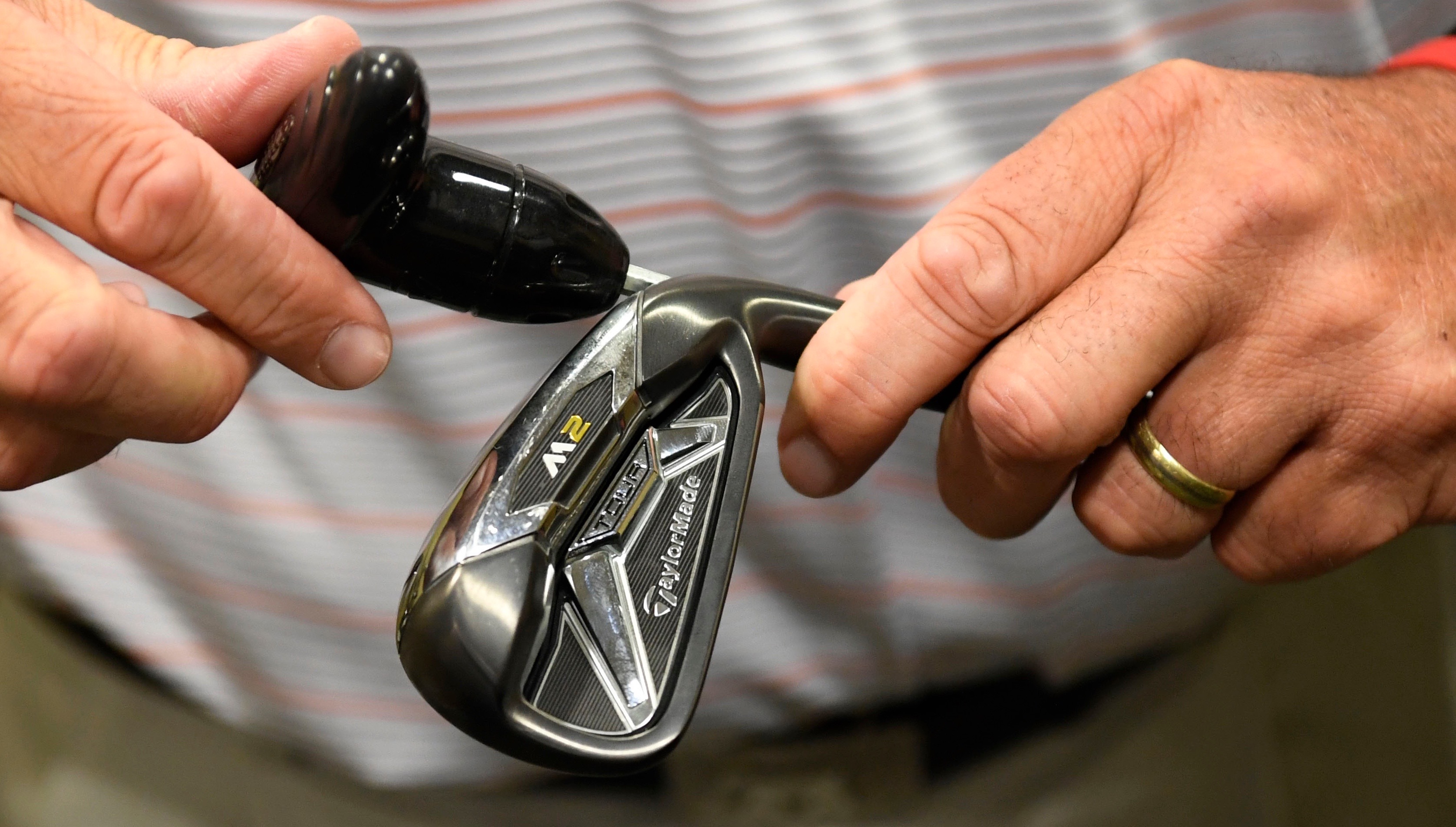
Throughout my golf career, I have been fortunate to spend time with some of the best club fitters in the world. Before I became a full-time golf instructor, I was a Tour Rep for TrackMan, which had me traveling around the U.S. and beyond to top club fitters and golf professionals. Through that experience, combined with my own teaching and fitting background, I have come to understand the many mistakes that can be made during a club fitting.
This article is not meant as a criticism toward any club fitter or golf professional. I simply want to pass on what I’ve learned to GolfWRXers and the greater golf community to do my part to make sure golfers don’t end up with a set of clubs that are a detriment to their games (and their wallets). These are the 5 biggest mistakes in club fitting.
1. Using Face Tape
Face tape has been used in club fitting for a long time. It is extremely helpful in showing us where on the club face a golf ball was struck, and it helps us understand more about why the ball is flying the way it does. This is the only way I would ever recommend using tape on the face of a golf club.
If you are a club fitter or a golf professional trying to protect your golf club during a fitting, it’s fine to put tape on the top or bottom of a wood to protect it from sole wear or potential sky marks. It’s a grave mistake to use tape on the face when you’re evaluating ball flight and/or launch monitor numbers, however, and you can see why in the example below.
With the tape on his driver club face, this golfer had about 700 more rpm of spin and 14 yards less total distance. If you are a golf professional and you want to dial in your students, DO NOT use face tape when you’re evaluating ball flight. A good alternative to face tape is Dr. Scholls foot spray. It may sound a little strange, but it will show where the ball was struck and have little to no effect on the ball flight.
2. Assuming Optimal Launch and Spin are Uniform
This is something I hear quite a bit, even from golf equipment manufacturers. Not too long ago, many in the golf industry were in agreement that the optimal launch and spin for any golfer with a driver for maximum distance was a 17-degree launch angle with 1700 rpm of spin. This might be true in a bubble, but we as humans have thousands of different combinations of swings and speeds, making this guideline almost completely useless. Take a look at some numbers for two very different golfers below: Player A and Player B. I want you to consider what you think good launch and spin should be for both.
Player A
Player B
In this scenario, I think most would assume that Player A (a low-speed player) would need significantly more spin to be optimal than Player B (a high-speed player). The rule of thumb is that the slower a golfer swings, the more spin they need to keep the ball in the air for maximum distance. Using that guideline, however, you wouldn’t optimize either golfer.
In club fittings, everything hinges on the specific needs of the golfer in front of you. The three main player inputs that determine optimal launch and spin are:
- Club Head Speed
- Attack Angle
- Desired Trajectory
In choosing a desired trajectory, a golfer has three options. They can opt for a high trajectory for maximum carry distance, a low trajectory for the most roll out (and sometimes the most total distance, depending on the conditions of the courses they play), or a combination that balances the two (carry and total). For simplicity, let’s assume both of these golfers want to optimize for the combination of carry and total. Now, let’s take a look at the optimization chart for each player below.
Player A Optimized
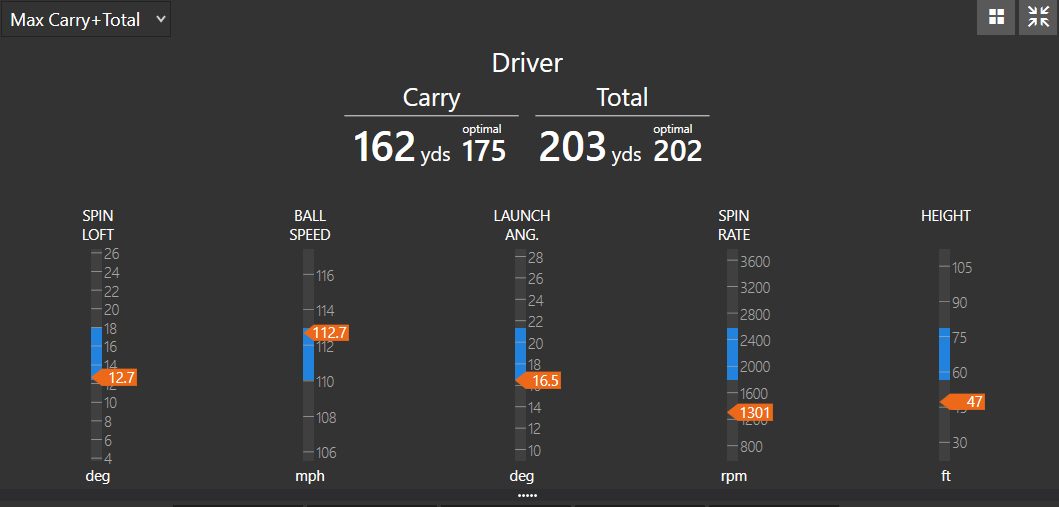 Player B Optimized
Player B Optimized
As it turns out, Player B with 135 mph of club head speed needs more spin than Player A with 76 mph of club head speed. It goes against my instincts, too, but it’s true. The reason is the Attack Angle for each player.
- Player A is hitting 5-degrees up on the ball, so he is already launching the ball into the air. For that reason, he doesn’t need as much spin for optimal distance.
- Player B is hitting 3-degrees down on the ball, so he needs more more loft and more spin to keep the ball in the air for optimal distance.
3. Only Looking at Distance Gained
This is the biggest and most common mistake I see during fittings. Both golfers and fitters are guilty of focusing on the one shot that travels 8-10 yards further during a fitting, and because it has the most distance potential, they assume that it’s the best club. I will never tell anyone that distance isn’t important, but I believe that too much emphasis has been placed on it in both driver and iron fittings.
Dispersion is huge for playability, and I suggest fitters take the time to allow golfers to hit plenty of shots in fittings. This allows them to not only optimize for distance, but also for dispersion.
Golf equipment manufacturers have given us fantastic equipment that can makes it very easy to adjust ball flight. The ability we have to tweak weighting, face angle, and lie angle can be vital to our ability to create a tighter dispersion. If you’re fitting outside, however, I encourage all fitters to go beyond the flat, perfect lies of the driving range. Have golfers hit shots from different lies and locations, and get them out on the course if you can. By testing clubs for the shots golfers are most likely to encounter during a normal round of play, you’re going to gain a much better understanding of what club will actually perform best for them.

Above are the Trackman numbers for a highly skilled junior golfer during a driver fitting. He was carrying shots about 245 yards with a total distance of 260 yards, and the ball was flying very straight. In the fitting, we were able to narrow down his best options to two drivers. With one of them, he cracked the longest shot he hit all day: 251.5 yards in the air, rolling out to almost 280 yards.
With that driver, he also recorded his fastest ball speed and best total distance by about 8 yards. When we look at the full picture, however, we will see it was not the best driver for him.
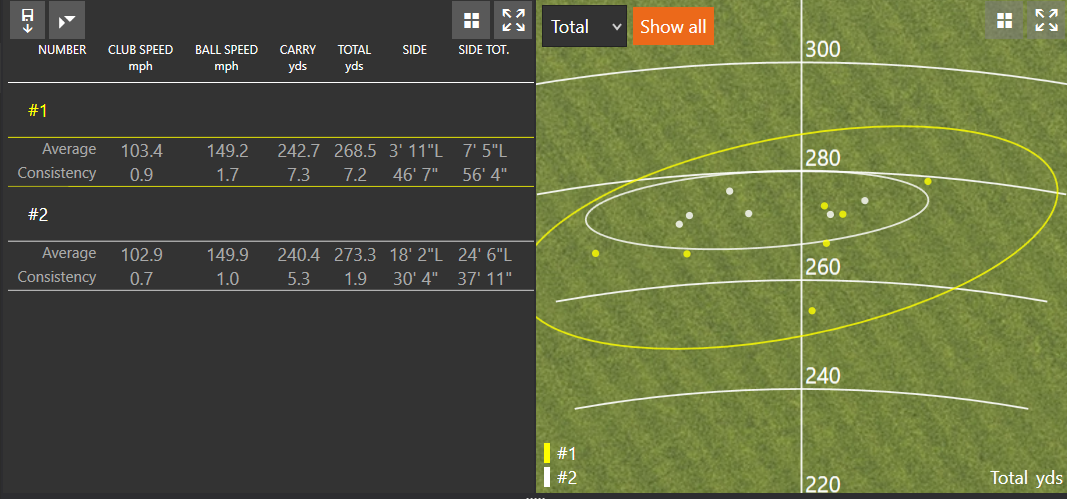
Driver #2 (white) is absolutely the most consistent in length and dispersion despite the fact that he hit Driver #1 (yellow) farther one time. Most golfers only think of their bad shots as “outliers,” when in fact they should often be discounting their very best shot with a club in the cases when the majority of their shots with the club are off-target.
4. Using a Lie Board

Lie boards are a thing of the past. There, I said it. Basing any loft or lie adjustments purely off a lie board is completely useless. On any well struck golf shot, the golf ball has already left the golf club before any significant ground and club interaction has occurred. This means the marks on the bottom of the club tells us next to nothing.
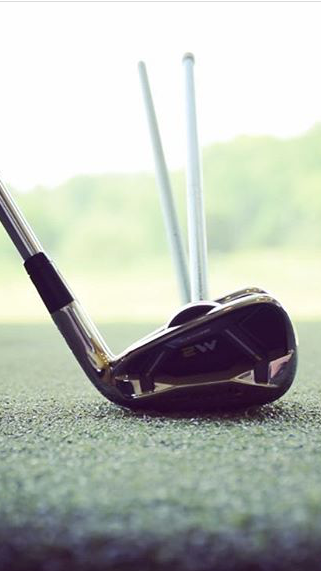
Above is a great picture from a friend of mine, Errol Helling. He’s the owner of Profectus Golf in Nashville, Tennessee. The photo shows the difference in where two golf clubs point at address: one at 3-degrees upright (pointing left) and one at 2-degrees flat (pointing right). It’s important to remember that the photo shows “static loft.” We are most interested in “dynamic loft” and the face angle at impact because that’s what effects ball flight. Just because we have an iron that is orientated a direction at setup does not mean it will point in the same direction at impact.
5. Looking at Divot Direction and Depth
Recently, this has been a frequent topic of discussion in the golf world. I hate to disagree with one of the greats of our game, Ben Hogan, but the secret is not in the dirt. I can’t say that Hogan was wrong, as his thoughts on the golf swing worked very well for him, but we now know that divot direction and divot depth tell us very little about ball flight. You can hit any kind of golf shot with every kind of divot, so why assume that the divot is going to tell us anything valuable?
Below are some pictures of shots I hit on the range. The divot direction is indicated by the alignment stick (on the left in each photo) that travels directly through the divot. The target line is the alignment stick on the right side of the picture. As you can see, the divots had no correlation to direction or curvature.
Shot #1
Shot #2
Shot #3
Shot #4
If you are trying to determine swing faults or fitting issues by looking at divots, you will be chasing an answer that does not exist. Keep your focus on impact location, face angle, club path, and angle of attack, and you’ll be on your way to better fittings.
- LIKE509
- LEGIT81
- WOW23
- LOL16
- IDHT13
- FLOP12
- OB2
- SHANK98
19th Hole
Vincenzi: The 8 best prop bets for the 2024 Masters
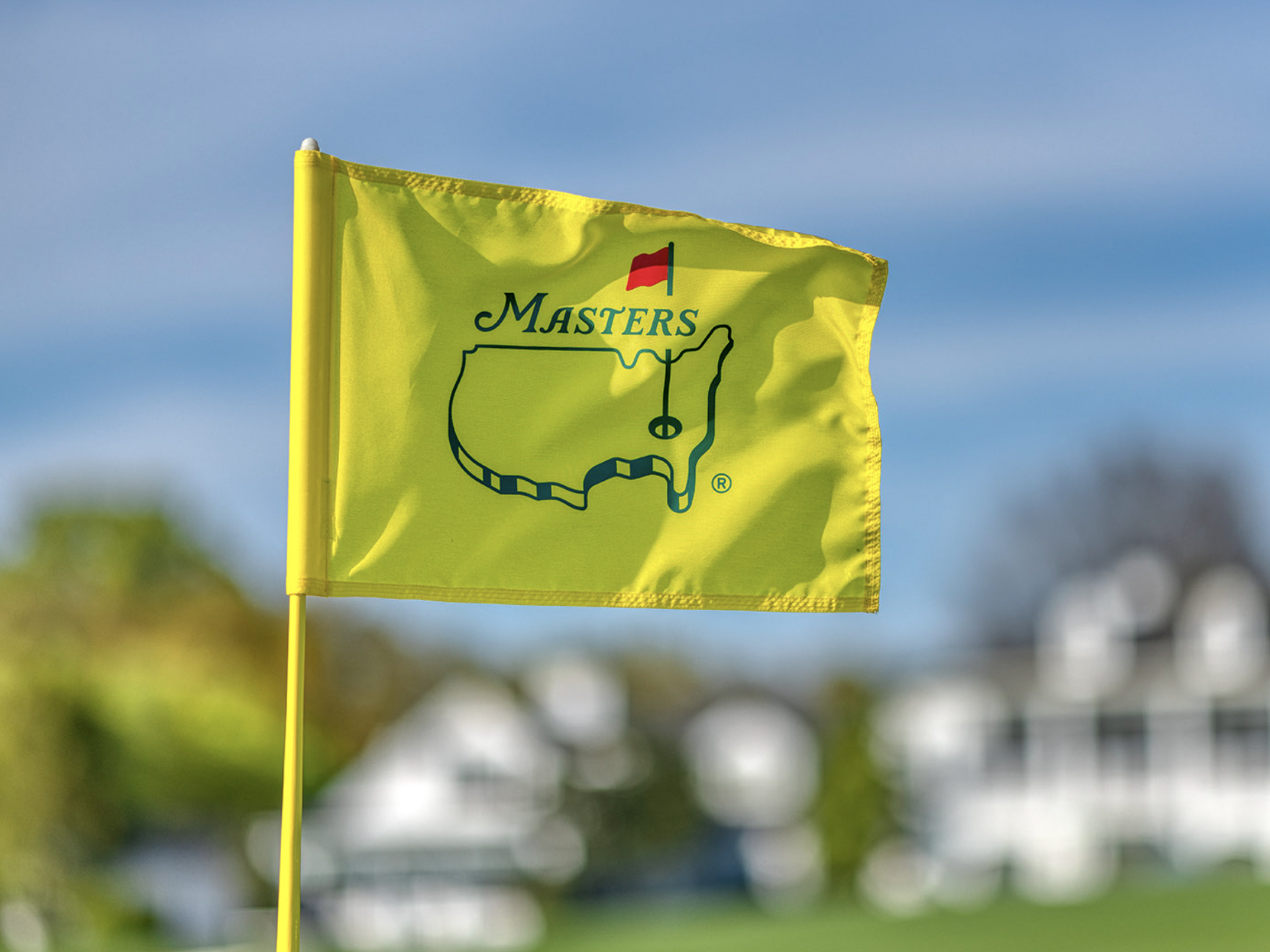
We’ve finally reached The Masters and excitement is at an all-time high. The world of golf has been fractured for the better part of two years, but for a week at Augusta National, all of the outside noise will disappear. All of the best players in the world will be together seeking to make history.
In addition to betting on The Masters champion. This is one of the few weeks of the year where there are so many more markets to explore, with value to be had in plenty of different categories.
Throughout this article, I’ll discuss all of my favorite props and players for the 2024 Masters.
Placement Bets:
Tony Finau Top 5 +750 (DraftKings):
I badly wanted to include Tony Finau in my outright betting selections, but I simply ran out of room on my card. Additionally, it’s slightly difficult to see him hitting the putts necessary to win the Masters on back nine on Sunday. However, I do strongly believe he will play great golf this week at Augusta National.
In his past 24 rounds, Finau ranks 4th in Strokes Gained: Approach is always amongst the best drivers of the golf ball in the game. Back in 2019, Finau had a great chance to win The Masters. I expect him to be hanging around over the weekend once again in 2024.
Gary Woodland Top 20 +550 (DraftKings), Gary Woodland to make the cut -110 (DraftKings):
Last season, Gary Woodland had his best ever finish at The Masters in his eleven tries. The 39-year-old finished T14 and played incredibly steady across all four rounds.
In Woodland’s most recent start at the Texas Children’s Houston Open, he struck the ball incredibly well. He led the field in Strokes Gained: Approach (+8.8) and Strokes Gained: Ball Striking (+10.0).
Gary has been working with Butch Harmon and absolutely flushing the ball both in tournaments and during practice.
Woodland appears to be healthy once again and in a great place physically and mentally. If he can build off his impressive performance at Augusta last year, he can place inside the top ten in 2024.
Additionally, the make the cut number on Woodland seems generous considering the number of players who miss the cut will be relatively small this week. Woodland is striking it well enough to make the cut even if he’s hindered by a balky putter once again.
Thorbjorn Olesen Top 20 +400 (FanDuel):
The Thunder Bear, Thorbjorn Olesen, made his Masters debut in 2013 and finished an incredibly impressive T6 for the week. In the two additional starts he’s made at Augusta National since then, the Dane has continued to be incredibly solid, finishing T44 and T21.
This week, Olesen heads into the week playing some good golf. He gained 3.8 strokes on approach and 5.52 strokes around the green at last week’s Valero Texas Open on his way to a strong T14 finish. Back in January, he won the Ras Al Khaimah Championship on the DP World Tour.
Olesen has the skill set to be successful at Augusta and seems primed for a good performance this week.
Top Nationalities:
Sergio Garcia Top Spanish Player +280 (DraftKings):
I believe Sergio Garcia can get into contention this week with the way he’s striking the ball in addition to his good vibes with a refurbished version of the Scotty Cameron that he used at the 1999 PGA Championship at Medinah.
I am slightly concerned about the emotional letdown he may face after losing in a playoff at LIV Miami, but I believe a veteran and former Masters champion should be able to regroup and focus on an event far more meaningful.
This is essentially a tournament head-to-head with Jon Rahm at +280. While Rahm deserves to be respected this week, the history of the lack of success of defending champions at The Masters is difficult to ignore.
Joaquin Niemann Top South American Player -230 (FanDuel):
While I hate paying this much juice, I don’t see a world in which Joaquin Niemann isn’t the top South American this week at The Masters. Joaco comes in playing better golf than anyone in the world not named Scottie Scheffler and has a serious chance to win the green jacket.
He only needs to beat two players: Emiliano Grillo and Camilo Villegas.
Tournament Head-to-Heads:
Justin Thomas -110 over Collin Morikawa
JT isn’t having his best season but is playing a lot better than he is getting credit for at the moment. In the past three months, there are only six players on the PGA Tour who have averaged 1.7 Strokes Gained: Tee to Green or better. Justin Thomas (+1.7) is one of the six and is currently tied with Rory McIlroy (+1.7).
Morikawa, on the other hand, has been extremely poor with his irons, which is incredibly uncharacteristic for him. I can’t help but feel like something is completely off with the two-time major champion.
Tony Finau -110 over Wyndham Clark
I explained in the placement section why I’m so high on Tony Finau this week. With how well he’s striking the ball, it seems as if his floor is extremely high. I’m not sure if he can make the putts to win a green jacket but I believe he will be in the mix similarly to 2019 when Tiger Woods emerged from a crowded pack of contenders.
Clark is a debutant, and while some debutants have had success at The Masters, it certainly poses a challenge. I also don’t believe Augusta National suits Clark as well as some of the other major championship venues.
- LIKE9
- LEGIT5
- WOW3
- LOL0
- IDHT0
- FLOP0
- OB0
- SHANK3
19th Hole
Vincenzi’s 2024 Masters betting preview: Niemann to play star role at Augusta National
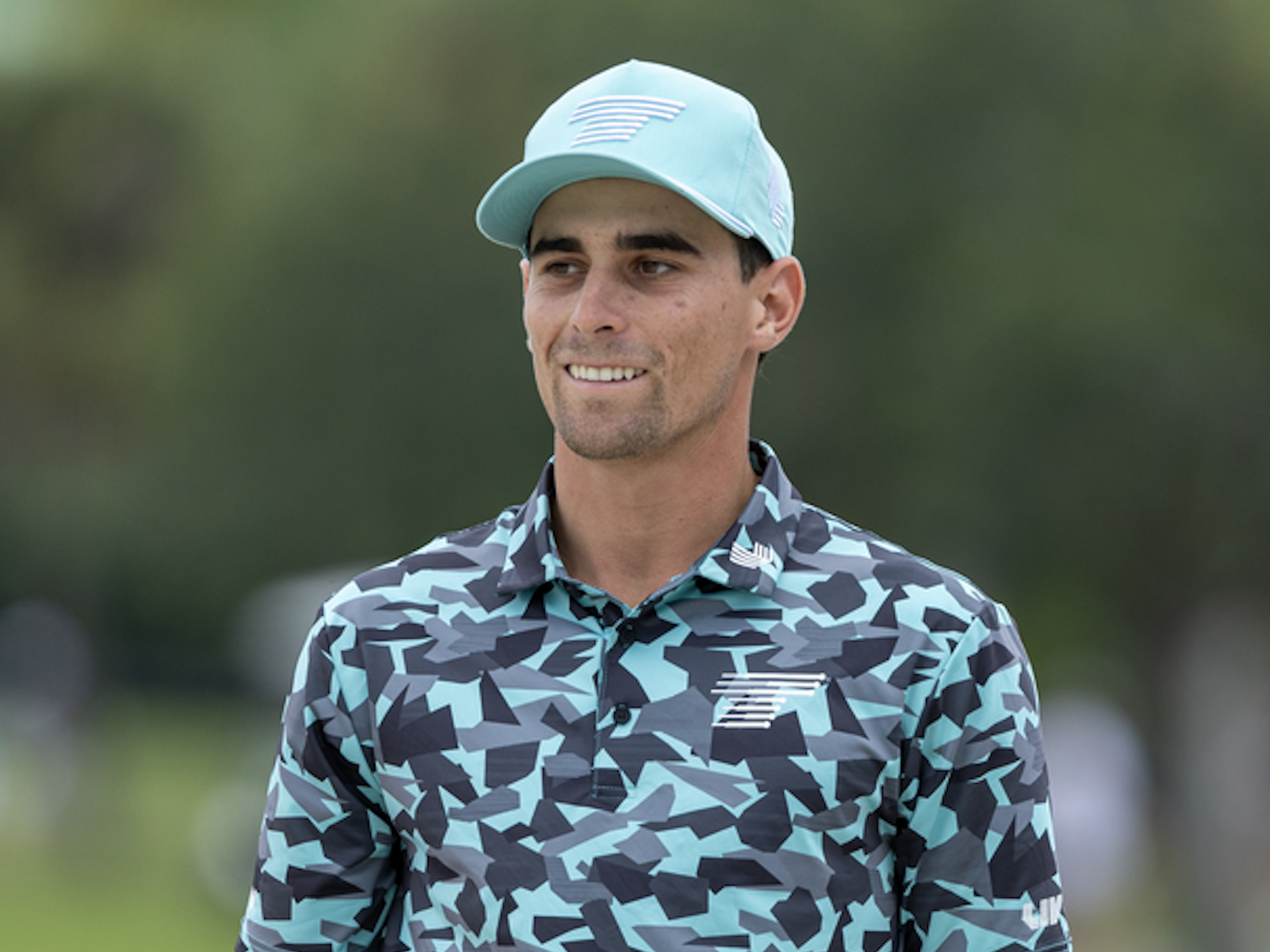
It’s been over nine months since we saw Brian Harman parlay a dominant performance at Royal Liverpool into a claret jug. After another major offseason filled with a feud between the PGA Tour and LIV Golf, talks of a merger, and a multitude of questions regarding the future of the game, the golf world is desperate for all of the best players in the world to come together again for a major championship.
We return to Augusta National with excitement at a fever pitch. Scottie Scheffler has separated himself as the best player in the world heading into the Masters. At the moment, the 27-year-old seems to be an unstoppable force. However, questions about Scheffler’s up-and-down putter once again resurfaced as he missed multiple short putts at the Texas Children’s Houston Open including a 5’11” putt to force a playoff with Stephan Jaeger.
Additionally, a handful of the PGA Tour’s top players such as Justin Thomas, Rory McIlroy, Will Zalatoris, Patrick Cantlay, Tommy Fleetwood and Jordan Spieth make their way to Augusta National with their current form in question.
Plenty of LIV golfers may be up to the task of conquering Augusta, but with so much time in between the last two majors, it’s not always easy to decipher how their games will stack up against Scheffler and co.
Last year, some important changes were made at Augusta National. The par-5 13th (Azalea) was lengthened by 35 yards and now measures 545 yards. Last year, Azalea played as the toughest of the four par 5s, and players averaged 4.74 for the week, which was down from 4.85 in 2022. However, eagles, birdies and bogeys were all up, so the lengthening achieved less pars, which equals more excitement.
Without further ado, let’s get into the course breakdown and analyze some important statistics for Augusta National.
Augusta National is now a 7,510-yard par-72 with lightning-fast Bentgrass greens. The course’s primary defenses are the contoured greens, swirling crosswinds, the topography of the course, which creates uneven lies and the small landing areas that golfers will need to hit to avoid tight run-off areas around the greens.
Past Winners at the Masters
- 2023: Jon Rahm (-12)
- 2022: Scottie Scheffler (-10)
- 2021: Hideki Matsuyama (-10)
- 2020: Dustin Johnson (-20)
- 2019: Tiger Woods (-13)
- 2018: Patrick Reed (-15)
- 2017: Sergio Garcia (-9)
- 2016: Danny Willett (-5)
- 2015: Jordan Spieth (-18)
- 2014: Bubba Watson (-8)
- 2013: Adam Scott (-9)
- 2012: Bubba Watson (-10)
- 2011: Charl Schwartzel (-14)
- 2010: Phil Mickelson (-16)
In this article and going forward, I’ll be using the Rabbit Hole by Betsperts Golf data engine to develop my custom model. If you want to build your own model or check out all of the detailed stats, you can sign up using promo code: MATTVIN for 25% off any subscription package (yearly is best value).
Key Stats For Augusta National
Let’s take a look at the six most important metrics at Augusta National and determine which golfers boast top marks in each category over their last 24 rounds. This should give us a good starting point for building out a betting card.
Strokes Gained: Approach
Approach is historically the most important statistic at Augusta National. The sloping, speedy greens and run-off areas create small landing spots that can be difficult to hit.
Last year, Jon Rahm ranked 6th in the field in Strokes Gained: Approach. Overall, five of the past seven winners at Augusta have ranked in the top 6 in the category. Distance helps, but Augusta National is a second-shot golf course.
Total Strokes Gained: Approach in past 24 rounds:
- Scottie Scheffler (+1.30)
- Corey Conners (+0.99)
- Shane Lowry (+0.88)
- Tony Finau (+0.85)
- Austin Eckroat (+0.85)
Course History
More so than any other course on TOUR, familiarity with Augusta National is crucial. Only one player has ever won the Masters on their first try — Fuzzy Zoeller in 1979. Meanwhile, there are 17 golfers in history who have multiple green jackets.
In most cases, the Masters champion has shown some good form at Augusta in the past. Prior to Scottie Scheffler’s 2022 victory, he finished T19 and T18 in his first two trips to the course. Prior to 2023, Rahm had finished in the top-10 of four of his six starts at The Masters.
Total Strokes Gained: Total at Augusta National in past 36 rounds (per round, minimum eight rounds):
- Will Zalatoris (+2.91)
- Jon Rahm (+2.28)
- Jordan Spieth (+2.22)
- Scottie Scheffler (+2.22)
- Dustin Johnson (+2.01)
- Rory McIlroy (+2.00)
- Hideki Matsuyama (+1.90)
- Justin Rose (+1.85)
- Rickie Fowler (+1.72)
- Russell Henley (+1.60)
Par 4 Scoring Average
Since plenty of players can reach the par 5s at Augusta in two, par-4 scoring becomes more important. The golfer who separates themselves on the par 4s will be able to gain ground on the field.
Par 4 Scoring Average in past 24 rounds:
- Scottie Scheffler (+3.88)
- Chris Kirk (+3.92)
- Jordan Spieth (+3.93)
- Peter Malnati (+3.93)
- Xander Schauffele (+3.93)
Strokes Gained: Around the Green
Golfers with a solid short game tend to fare well at Augusta National. The run-off areas are treacherous, and players will often be scrambling to get up and down.
The majority of players who have won at Augusta National have a great short game and have shown consistent ability to get up and down from tough spots.
Total Strokes Gained: Around the Green in past 24 rounds:
- Hideki Matsuyama (+0.71)
- Scottie Scheffler (+0.66)
- Patrick Reed (+0.61)
- Xander Schauffele (+0.53)
- Lucas Glover (+0.51)
Strokes Gained: Off the Tee
Augusta National is most definitely a second shot golf course. Golfers can get away with a missed fairway here and there, however, it’s important that the misses with driver aren’t too wide of the target or there is serious trouble to be had.
Total Strokes Gained: Off the Tee in past 24 rounds:
- Bryson DeChambeau (+1.04)
- Rory McIlroy (+0.85)
- Scottie Scheffler (+0.84)
- Xander Schauffele (+0.71)
- Ludvig Aberg (+0.68)
Strokes Gained Putting: Fast Bentgrass
The USGA calculates that, on average, the greens at Augusta National are the fastest greens in the country. Three-putting is fairly common at Augusta and golfers must be able to combat the speed of the greens with effective lag putting.
Total Strokes Gained: Putting on Fast Bentgrass in past 24 rounds:
- Justin Rose (+1.43)
- Sahith Theegala (+0.97)
- Min Woo Lee (+0.88)
- Cameron Smith (+0.70)
- Patrick Reed (+0.70)
Statistical Model
Below, I’ve reported overall model rankings using a combination of the six key statistical categories previously discussed.
These rankings are comprised of SG: App (25%); Course History (16%); Par 4 Scoring Average (10%); SG: Putting on Fast Bentgrass (16%); SG: OTT (16%). and SG: ARG (16%).
Last year, Jon Rahm ranked first in this model
- Scottie Scheffler
- Xander Schauffele
- Hideki Matsuyama
- Tony Finau
- Justin Thomas
- Shane Lowry
- Will Zalatoris
- Corey Conners
- Si Woo Kim
- Rory McIlroy
- Stephan Jaeger
- Jordan Spieth
- Chris Kirk
- Keegan Bradley
- Wyndham Clark
- Sahith Theegala
- Russell Henley
- Collin Morikawa
- Matt Fitzpatrick
- Patrick Reed
My 2023 Pick:
Jon Rahm (+950) (FanDuel)
A few months ago, I never thought that I’d be able to say that Rahm would be going slightly under the radar heading into the 2023 Masters. It’s not that Rahm has done anything wrong, but both Scheffler and McIlroy have undoubtedly surpassed him as the scorching hot, super-elite, top of the market betting favorite category.
Since his win at Riviera, the Spaniard has finished 39th at Bay Hill, withdrew at The Players Championship, and failed to get out of the group stage at the WGC Dell Match Play. On the other hand, Scheffler won The PLAYERS Championship and McIlroy finished third at the WGC Dell Match Play.
Rahm has made six starts at The Masters and has come in the top-10 in four of them. The 28-year-old has incredible power off the tee, a requirement at Augusta which always plays longer than the scorecard indicates. He’s also incredible around the greens and ranks third in the field in Strokes Gained: Short Game, which is a combination of around the green play and putting, in his past 24 rounds.
As we’ve seen over the years at The Masters, having the ability to chip and putt your way out of difficult situations is a fundamental aspect of getting it done at Augusta National.
While Scheffler has made a strong case to be viewed as the world’s best player, I still believe that title belongs to Rahm. This will be the year Rahmbo joins the ranks of Seve Ballesteros, José María Olazábal, and Sergio Garcia as natives of Spain to don a green jacket.
2024 The Masters Picks
Brooks Koepka +2500 (DraftKings)
In order to win the 2024 Masters, a player will have to go toe-to-toe with Scottie Scheffler, who’s hitting the ball as anyone in golf over the last two seasons. When building a betting card this week, it’s important for me to choose players that I believe can stare Scheffler down on the weekend at Augusta National. Brooks Koepka fits that bill.
Koepka’s lackluster performance at LIV Miami is concerning, but he’s the type of player who can turn it on quickly during the week of a major championship. Although I’d have preferred, he played well last week, I’ll take the odds discount we got as a result of his most recent results.
Prior to LIV Miami, Koepka appeared to be in solid form. He finished in the top twelve in four of five starts on LIV this season. When it comes to the five-time major champion, it’s well known that he has another gear for major championships. Everything he’s done both in the off-season and during the LIV season is to gear up for the year’s first major at Augusta National.
In his past five starts at Augusta National, the 33-year-old has three top-7 finishes, including two runners-up. The two years when he played poorly (2019 and 2020) were when he was nowhere near 100% healthy. All signs point to Brooks being in a great place physically as we enter major season.
Last year, Koepka was the 36 and 54-hole leader prior to letting the green jacket slip away to Jon Rahm. He used the result as a springboard to win his 5th major at Oak Hill at the PGA Championship.
Brooks enters the week looking to get one step closer to achieving the career grand slam and golf fans would be foolish to rule him out.
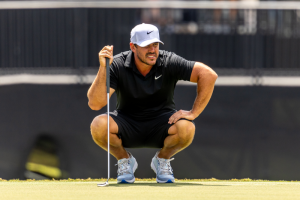
Joaquin Niemann +2800 (BetRivers)
Full disclosure, I bet Niemann the second he was invited to The Masters back in February at +8000. Although the odds have shortened dramatically since then, I can’t pretend that the Chilean isn’t one of the players who has a real chance to win the 2024 Masters.
While I was speaking with Niemann back in March, he told me how much he loves Augusta National.
“Yeah, it’s a place that I love. I’ve been playing good golf. Especially last year, I wasn’t playing my best golf, and I had a good week there and made triple on 11 that kind of killed me a little bit.
I feel like I’m getting more ready and more prepared every time. My game is getting better too. I know that I’m playing good enough to be in that situation that I can have a chance to win the Masters and it’s all about how I react to that situation.
So yeah, I’m going to prepare myself to be ready for that situation if it happens and I can fight for the title on the Sunday which would be awesome.”
As Niemann alluded to, the Chilean was able to have his best career finishes at The Masters (T16) despite not being in the best form. This year, Niemann comes into the week playing better golf than anyone in the world with the exception of Scottie Scheffler. The 25-year-old has won three times since December and has shown the world why he was regarded as one of the games future stars since he was a teenager.
Historically speaking, Joaco’s win at Riviera a few years back seems to be an indicator of potential success at Augusta National. Fourteen players have won at both historic courses including Hideki Matsuyama, Jon Rahm, Phil Mickelson, Dustin Johnson, Nick Faldo, Tom Watson and Ben Hogan.
Niemann has all the shots to be successful at Augusta National. His low stingers will come in handy on plenty of holes down the stretch and he can work it both ways, playing the high draw or the low fade. He also putts best on Bentgrass greens and likes them fast. Whether PGA Tour or LIV, talent will always reign supreme, and I’ll always bet on that talent.

Cameron Smith (+4000) (FanDuel)
Cameron Smith is another player who we should get an odds discount on based off of the results at LIV Miami. Smith was forced to withdraw prior to the second round due to food poisoning. In my opinion, the number has drifted to a place where I’d consider it a “bet the number” play on the talent.
Smith is a contender for the green jacket anytime he tees it up at Augusta National. The Australian absolutely loves the golf course and has four top-10 finishes in his last six trips to the golf course. In both 2020 and 2022, Smith had a real chance of winning The Masters and came up just short, finishing T2 and T3 in those two tries. In his past 36 rounds, he ranks 4th in Strokes Gained: Total per round at Augusta.
In order to be successful at Augusta National, players must be creative around the greens and be shot makers who have plenty of ways to get around the golf course. Cam has all the shots required to be successful at the course at his touch around the greens will continue to serve him well in his hopes for a green jacket.
Smith is arguably the best putter in the world and has the capability to win a golf tournament on and around the greens. He’s already taken down Rory McIlroy at the home of golf on his way to a claret jug and is one of the few players who can stare down any of the world’s top golfers on the back nine at Augusta National.

Justin Thomas +4000 (FanDuel)
With how he’s been playing since his 2022 PGA Championship win, you may be shocked to see the name “Justin Thomas” in this preview. However, JT has drifted to a place on the odds board where I believe it’s worth taking a shot on the talent of a two-time major champion in his prime.
It’s not all bad for Thomas this season. He finished T6 at the signature Pebble Beach event, T12 at the Waste Management Phoenix Open and T12 at the signature Arnold Palmer Invitational. In his last 24 rounds, JT ranks 8th in the field in Strokes Gained: Approach, 14th in Strokes Gained: Around the Green and 29th in Strokes Gained: Putting on fast Bentgrass greens.
Despite missing the cut last season, Thomas has played pretty well at Augusta National. He ranks 13th in Strokes Gained: Total in his past 36 rounds at the course. He finished T4 in 2020, T21 in 2021 and T8 in 2022.
I believe the 2024 edition of The Masters is completely wide open. The past few years has been frustrating for Thomas fans, but I believe his peak form may be a bit closer than people realize.
Sergio Garcia +12000 (FanDuel)
Earlier this season, Garcia dueled with Joaquin Niemann before finally losing on the fourth playoff hole late into the night. Despite the loss, the 44-year-old seemed to gain confidence in his game. The results that followed weren’t spectacular, but in terms of his ball striking he’s shown some flashes of vintage Sergio.
At LIV Miami last week, Garcia played well on a massive golf course, losing in a playoff to Dean Burmester. He continued pumped the ball into the fairway and hit massive iron shot after massive iron shot. He also used a refurbished Scotty Cameron that he used in the 1999 PGA Championship at Medinah. The putter served him incredibly well until he missed a short putt on the 18th hole to win the event. Overall, he gained 7.1 strokes putting at Doral.
Sergio Garcia is once again headed to Augusta National with a chip on his shoulder. Of course, having a chip on the shoulder is nothing new for the fiery Spaniard, but this year, the 2017 Masters Champion will arrive at Augusta with his game clicking on all cylinders.
Sergio winning a second green jacket is seemingly an almost impossible feat, but magical things tend to happen on the hallowed grounds of Augusta National.
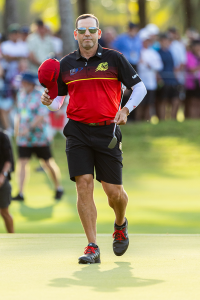
Adam Scott +11000 (FanDuel)
Betting Adam Scott over the past handful of years has been a Masters staple for me, and like many traditions, has been a hard one for me to let go of.
Last week, Scott finished T14 at the Valero Texas Open in a windy and difficult week. I believe the wind will be a major factor this week at Augusta National, and the more difficult the tournament plays, the more I favor Scott. Scott also ranks 5th in his past 24 rounds on Strokes Gained: Putting on Fast Bentgrass and has the short game these days that could help him contend in a major.
Since his win in 2013, Scott’s history at The Masters has been spotty. He has some poor finishes alongside a T9 in 2017 and a T18 in 2019. He’s been playing some solid golf this season, finishing T8 at the Waste Management Phoenix Open and T19 at the Genesis Invitational.
(All photos in piece belong to LIV Golf)
- LIKE35
- LEGIT22
- WOW8
- LOL2
- IDHT0
- FLOP6
- OB2
- SHANK23
Opinion & Analysis
The 22 players who can win the Masters
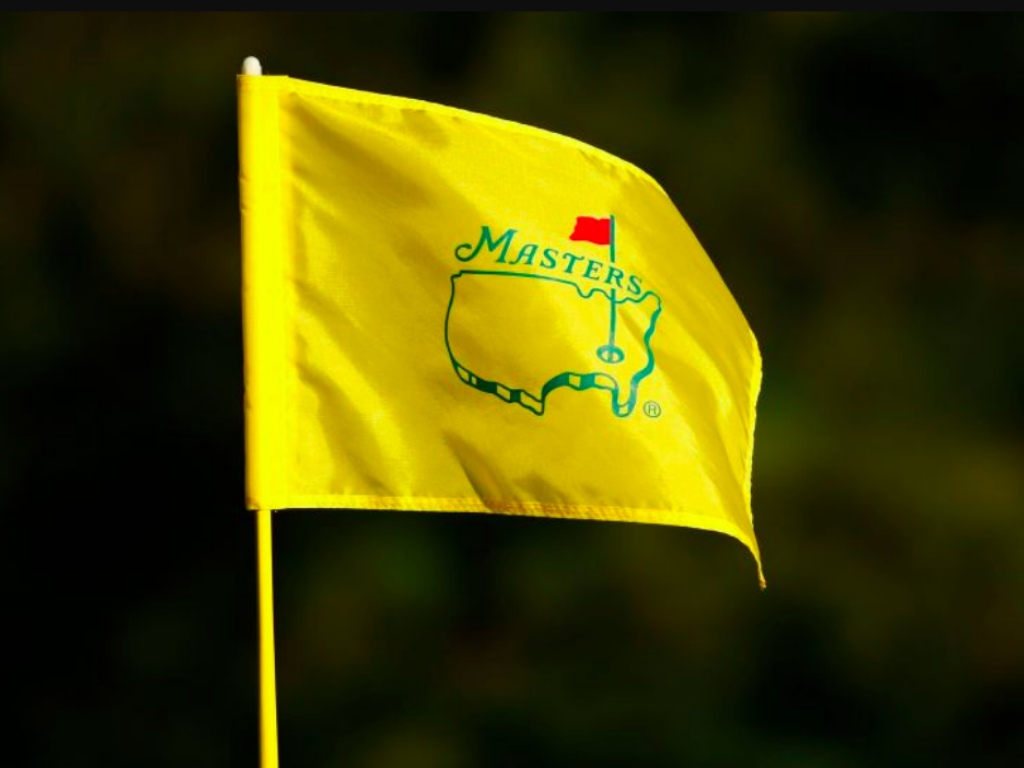
Since 2013, I have created a filtering process to help determine the players who are most likely to win the green jacket based on criteria that have strongly predictive outcomes to success at Augusta. The list of players that can win at Augusta is usually filtered down to 20-24 players and in that time I have correctly shortlisted every Masters champion.
This includes last year’s winner, Jon Rahm. Even though Rahm essentially walked away with the green jack and did not make it very close, there were some close calls on top of the leaderboard as I had filtered out Phil Mickelson (t-2nd) and Patrick Reed (t-4th) as the LIV Tour is still behind on providing advanced analytics for their tour. Russell Henley was also filtered out and finished t-4th, five strokes from Rahm’s winning score of 276.
If you’re watching at home, the “critical holes” that will likely determine the top finishers will be holes No. 7, 8, 11 and 13. The 11th hole is projected to be the most critical of holes as over the past five Masters the top players have gained nearly a 1.5 strokes for the tournament on that hole alone.
Just like last year’s column I will get the LIV Tour players I’ve filtered out of the way. Since LIV Tour does not provide ShotLink or Trackman data, it’s more of a guessing game as to how certain LIV Tour golfers are playing. I did utilize recent performance as well as performance at Mayakoba and Doral as they were two former PGA Tour courses that have some semblance of crossover to playing Augusta.
Phil Mickelson
Thorbjorn Olesen
Charl Schwartzel
Cameron Smith
Bubba Watson
Admittedly Cameron Smith and Phil Mickelson are hard to leave out, but both have not played well as of late.
Next, I filtered out the amateurs and all first-time professional attendees. The Masters has only been won three times by a first-time attendee: Fuzzy Zoeller was the last to win in 1979. Prior to Zoeller though, it was Horton Smith in the inaugural event in 1934 followed by Gene Sarazen in 1935
Ludvig Aberg
Akshay Bhatia
Wyndham Clark
Eric Cole
Santiago de la Fuente (a)
Nick Dunlap
Austin Eckroat
Stewart Hagestad (a)
Ryo Hisatsune
Lee Hodges
Nicolai Hojgaard
Stephan Jaeger
Jake Knapp
Christo Lamprecht (a)
Peter Malnati
Denny McCarthy
Grayson Murray
Matthieu Pavon
Adam Schenk
Neal Shipley (a)
Jasper Stubbs (a)
Out of the first time invitees the data likes Ludvig Aberg and Eric Cole to play the best at Augusta National.
I also filter out old Masters champions that I do not believe can get into contention anymore.
Fred Couples
Jose Maria Olazabal
Vijay Singh
Mike Weir
Tiger Woods
Recency has a strong predictive value for player performance and missing the cut in the event in the prior week greatly reduces the likelihood of winning the following week compared to players that miss the cut, take a week off, and then play the following week. Therefore I filter out all players that missed the cut at the Valero Texas Open last week.
Byeong Hun An
Harris English
Rickie Fowler
Ryan Fox
Zach Johnson
Tom Kim
Erik van Rooyen
Camilo Villegas
I will also filter out the players that have never made the cut at the Masters:
Kurt Kitayama
Adrian Meronk
A Tradition Unlike Any Other…
Augusta National has traditionally favored longer hitters and even moreso in the past 20 years of the event. Of course there has been exceptions as in 2007 the short hitting Zach Johnson ended up winning the event.
Critics of my filtering system point out Johnson’s victory as a case for short hitters being able to win at Augusta, but they neglect the fact that Johnson’s victory came in historically low temperatures in the 40’s with wind gusts reaching 35 mph. That made the par-5’s almost unreachable in two shots and the course stressed wedge play and short game around the green where Zach had a sizable advantage.
It is projected to rain early on Thursday and then the weather is supposed to be sunny and warm for the rest of the week. It depends on how quickly the course dries up, but if it does dry out fairly quickly that will give the longer hitters the advantage as they will be able to reach certain par-5’s in two shots that the shorter hitters cannot reach if they don’t hit a quality tee shot and there may be par-5’s that some of the long hitters can reach in two shots with a short iron. Therefore I will filter out the following players due to a lack of distance off the tee:
Corey Conners
Lucas Glover
Emiliano Grillo
Brian Harman
Si Woo Kim
Chris Kirk
Shane Lowry
Colin Morikawa
JT Poston
Justin Rose
Sepp Straka
Out of these players the data likes Lowry and Morikawa the most. Both have good history at Augusta and they both just narrowly missed the distance benchmark set in the filter and both are excellent long iron players.
Last year I created a new formula to better determine ball height as Augusta has historically not taken too kindly to a low ball flight. Out of the 5 players filtered out for low ball flight using the new formula the best finish was only t-29th by Si Woo Kim. This year I’ve filtered out the following players.
Matthew Fitzpatrick
Sungjae Im
Luke List
Joaquin Niemann
Justin Thomas
Every year I filter out the poor performers on approach shots from 175-225 yards as Augusta National puts a lot of stress on those shots. Last year I filtered out nine players and three of them missed the cut with only Jordan Spieth finishing in the top-15 (t-4th) as the rest of the players were never a threat.
Here are the golfers I’m filtering out due to poor play from 175-225 yards:
Patrick Cantlay
Cameron Davis
Jason Day
Tommy Fleetwood
Russell Henley
Max Homa
Rory McIlroy
Jordan Spieth
Nick Taylor
Rory had a nice outing at the Valero Texas Open and hit his irons better there, but appears to be struggling with a leftward miss. Other than that, Rory still has the game to win his first green jacket. Henley is usually one of the better iron players on Tour, but he has struggled this season from 175-225 yards and is a short hitter anyway.
I will also filter out Danny Willett as he is coming off injury and making his comeback at the Masters.
That leaves the 22 players that can win the Masters:
Keegan Bradley (150/1)
Sam Burns (60/1)
Bryson DeChambeau (25/1)
Tony Finau (50/1)
Sergio Garcia (100/1)
Adam Hadwin (175/1)
Tyrrell Hatton (80/1)
Viktor Hovland (35/1)
Dustin Johnson (40/1)
Brooks Koepka (16/1)
Min Woo Lee (70/1)
Hideki Matsuyama (20/1)
Taylor Moore (300/1)
Jon Rahm (12/1)
Patrick Reed (80/1)
Xander Schauffele (18/1)
Scottie Scheffler (4/1)
Adam Scott (100/1)
Sahith Theegala (50/1)
Gary Woodland (250/1)
Cameron Young (50/1)
Will Zalatoris (35/1)
Here’s my personal top-10 picks:
Keegan Bradley (150/1)
Sam Burns (60/1)
Bryson DeChambeau (35/1)
Tony Finau (50/1)
Viktor Hovland (35/1)
Dustin Johnson (40/1)
Hideki Matsuyama (20/1)
Jon Rahm (12/1)
Xander Schauffele (18/1)
Scottie Scheffler (4/1)
- LIKE186
- LEGIT75
- WOW24
- LOL25
- IDHT5
- FLOP17
- OB7
- SHANK67
-

 19th Hole5 days ago
19th Hole5 days agoDave Portnoy places monstrous outright bet for the 2024 Masters
-

 19th Hole3 weeks ago
19th Hole3 weeks agoJohn Daly stuns fans into silence with brutal opening tee shot on PGA Tour Champions
-

 19th Hole2 weeks ago
19th Hole2 weeks agoThings got heated at the Houston Open between Tony Finau and Alejandro Tosti. Here’s why
-

 19th Hole6 days ago
19th Hole6 days agoTiger Woods arrives at 2024 Masters equipped with a putter that may surprise you
-

 19th Hole2 weeks ago
19th Hole2 weeks agoReport: Tiger Woods has ‘eliminated sex’ in preparation for the 2024 Masters
-

 19th Hole3 weeks ago
19th Hole3 weeks agoCharlie Woods finds it tough going on American Junior Golf Association debut
-

 19th Hole2 weeks ago
19th Hole2 weeks agoAddiction, spinal fusion, and scam artists – Everything Anthony Kim revealed in candid interview with David Feherty
-

 19th Hole1 week ago
19th Hole1 week agoAnthony Kim says doctors told him that he ‘may not have much time left’ ahead of LIV return

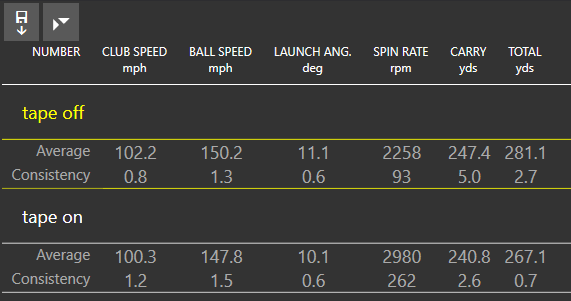
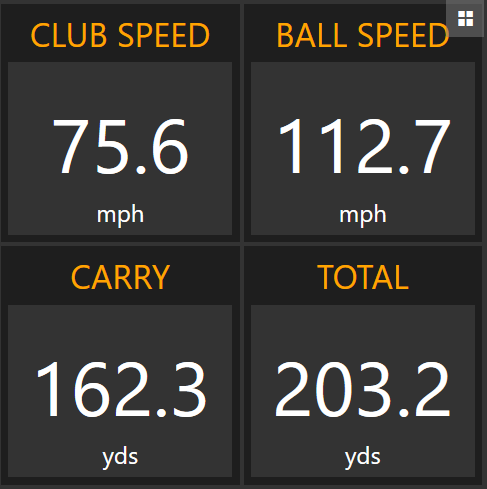
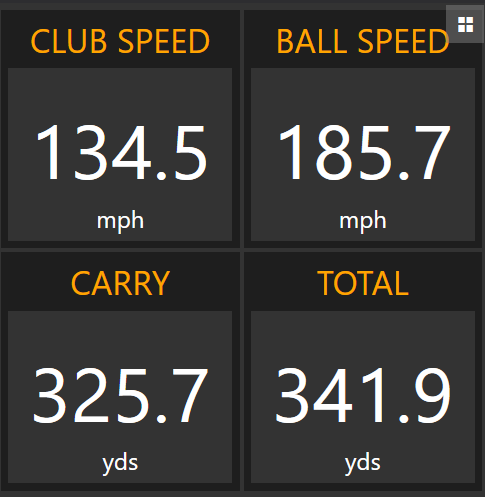
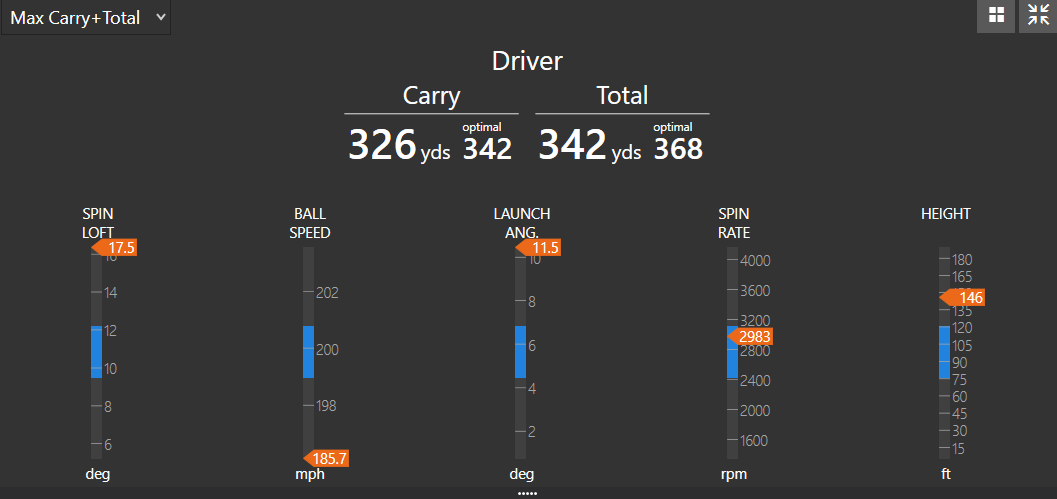
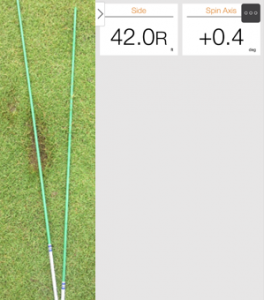
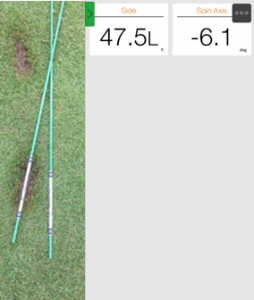
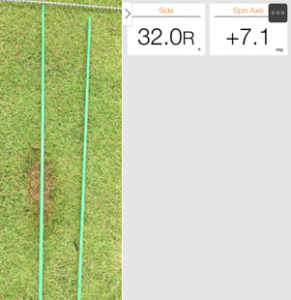
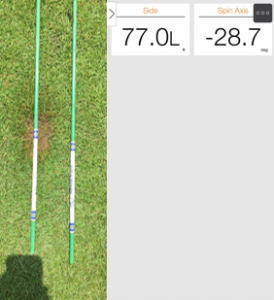
















when_is_a_wrench_not_a_wrench
Aug 27, 2017 at 3:29 pm
Did anyone notice the main photo shows someone pretending to insert a wrench into a M2 Tour Iron head?
Beta
Aug 27, 2017 at 8:22 pm
Yeah? So? It’s a Fitting head. They have one of those last year lol so he’s not pretending
SoonerSlim
Aug 27, 2017 at 11:02 am
Hunter, very interesting article, but for me it did not go far enough because I’ve never seen and do not understand what the side and spin axis numbers you offer for the divot pictures represent. Unfortunately, you did not go far enough and offer an explanation for them. For example, what’s the difference between + and – spin axis? What does the side number mean? Great article except for the last part.
thanks, SoonerSlim
Hunter Brown
Aug 27, 2017 at 1:28 pm
Sooner, thanks for reading and giving your feedback. You are probably right I should have included some definitions about Spin Axis and Side. Coming from that world sometimes I forget not everyone knows the terminology. Spin axis represents which way the golf ball is curving so if positive the ball is curving to the right and if negative it is curving to the left. Side represents how far off of the target line the ball landed. Hope this helps! If you want to learn more about TrackMan Definitions visit the trackman blog.
SoonerSlim
Aug 27, 2017 at 9:34 pm
Thanks, Hunter
Never have seen or used a trackman, too old school I guess.
S
Michael
Aug 26, 2017 at 11:10 am
What if your line is straight on the club face but out towards the toe?
Beta
Aug 27, 2017 at 8:24 pm
Stand closer? Juuuuust kidding.
Jeffrey
Aug 26, 2017 at 4:14 am
Heres an idea. Why don’t we go out with our golf clubs and hit the ball and have some fun and forget about all this numbers/fitting/trackman/drills/etc BS. If you play good, great. If you play bad, there is always next time.
emb
Aug 28, 2017 at 2:49 pm
ya who cares about shooting your best possible scores, might as well buy your equipment from walmart and play top flites right
Stevegp
Aug 25, 2017 at 11:50 pm
Enjoyed the article and subsequent discussion. Getting fitted and hitting a club outdoors always seemed much different–and better–than hitting into a net while indoors.
Guia
Aug 25, 2017 at 6:38 pm
I am lost! Seems most of what has been accepted in the past is wrong, or misused.
Marooned
Aug 25, 2017 at 6:04 pm
No idea of how the “fitting culture” are in the states. But here in Europe (Sweden) most of this is common sense except your point of the lieboard.
It is such a great and easy tool and a must have. One thing about lie though that I feel is that many people just hit a couple of shots with an 7-iron and that sets the marknfor the lieangle throughout the set.
A longer iron such as an 4-iron often needs a more upright lieangle then a 9-iron for example.
The majority of people a do an lietest with hitting a 4, 7 and 9-iron are hitting it more on the toe with a 4-iron compared to the 9-iron.
Bert
Aug 26, 2017 at 6:23 pm
Good thoughts – I’ve always just hit a 6 or 7 off the lie board. I’ve measured all my lofts and lies but tomorrow I’ll hit the long irons and short irons off the board and note the results.
Bob
Aug 25, 2017 at 4:22 pm
Gee, it seems like there is a lot of disagreement about proper club fitting technique. I have gotten advice about clubs on several occasions but never really had a fitting. One reason is that I have heard so much disagreement about how it should be done and am not aware of any standards or any acknowledged experts (e.g. Ping vs Callaway, etc.). I suppose the best shot might be to work with a pro, who also provides instruction and who will be around to provide guidance after new clubs are purchased or current clubs are adjusted for length, loft, lie, swing weight, grip, etc. The big question is why spend a lot of money, if you don’t know what you are buying?
Rors
Aug 25, 2017 at 4:15 pm
Steve Elkington has a video on youtube about dynamic fitting for irons… He marks a ball with a sharpie and that mark imprints on your club… I tried it and its the best…
Ben Jones
Aug 25, 2017 at 3:24 pm
Good Lord! How did we survive before technology. Now, I can get some really great clubs perfectly fit for me on that day for $4,000 or more, but if my swing ain’t worth crap and I can’t putt, what good is all this?
Lorne
Aug 25, 2017 at 3:19 pm
Clubs have a ‘static’ lie and a ‘dynamic’ lie which is a function of shaft tip ‘droop’. The position of the hands and club butt end changes through release and impact, which will affect the shaft lie.
The weight and shape of the clubhead will affect dynamic lie because the clubhead CofGs vary the droop characteristics of the shaft. Shaft specs influences dynamic loft as does downswing plane and clubhead speed which can vary as the golfer fatigues during the round.
So we have how many variables for dynamic lie? 6? 7? 8? 9? More? Less?
A good fitter can measure several of these lie factors but must also use intuitive knowledge to match the golfer to the optimal shaft and clubhead, and grip too. Good luck.
Tata
Aug 25, 2017 at 2:41 pm
In regards to #3.
I can guarantee you that 9 out of 10 amateurs who can’t hit their driver past 200 yards is solely focused on that aspect. They don’t care about anything else, because they all believe that once their distance is sorted out, that they can then learn to control their ball flight. Which is deadly absolutely true.
Dave
Aug 25, 2017 at 2:28 pm
Very interested in this article, yes I understand how you can determine lie angle by using a marker pen on the ball and Callaway use this method a lot with there fitting. We use the marker on the ball when fitting outdoors, but indoors with launch monitor the Marker ruins the white screen we have for our projector and leaves black marks on the screen. Would be interested to know if there are any other ways of determining a correct lie angle without the option of a lie board or marker pen on a ball???
Noodler
Aug 25, 2017 at 8:26 pm
I temporarily hang a black tarp/net in front of the screen to prevent the marker from being left on the white screen.
Hunter Brown
Aug 25, 2017 at 8:28 pm
Dave I would suggest always keeping your focus on flight and dispersion. From there if you need to make adjustments to lie angle you can but it shouldn’t be the first thing we go to
Noodler
Aug 26, 2017 at 9:21 am
Sorry Hunter, but I believe this is misguided advice. Golfers should be fit to their physique, strength, flexibility, etc., not to their swing mechanics. Swing mechanics will change over time (even day to day). Using lie angle adjustment to compensate for swing flaws is not the right approach. Trying to use club fitting to compensate for swing flaws is the 6th biggest mistake in club fitting.
Hunter Brown
Aug 27, 2017 at 9:19 am
Why can’t it be both? I never said you shouldn’t fit for the human being in front of you. Too much mutual exclusivity in your train of thought.
TexasSnowman
Aug 25, 2017 at 11:31 am
Agree with the comments on hitting indoors; I never feel like I hit my best shots. Club Fitting needs some type of standards or certification for competence. Even if you pay for a “tour level” fitting, you really have no idea if the fitter knows what he is doing… I’m not saying take all the ‘art’ out of the process, but it’s really the wild west out there in terms of quality.
Bobalu
Aug 25, 2017 at 10:50 am
Hunter- Great points! Fittings need to be done with a competent fitter with Trackman on the range. Period. Good luck finding this.
ADIDAG
Aug 25, 2017 at 10:36 am
Looks like to get optimum anything players need to focus on roll
Nack Jicklaus
Aug 25, 2017 at 9:59 am
You can get a good idea if your lie angle is correct by drawing a straight line around the circumference of a ball with a sharpie. Sit the ball on the ground with the line pointing straight up and down and with the line also pointing directly where you intend to hit the ball (just like people who line up putts with a line drawn on their ball). Now hit your shot and some of the sharpie line will stick to the face of your club. If the line is perfectly perpendicular to the grooves on your club, then your lie angle is correct. If not, it needs changing one way or the other.
Steve
Aug 25, 2017 at 12:47 pm
100% spot on. Well done.
Hunter Brown
Aug 25, 2017 at 6:26 pm
I agree with this however if the line is perpendicular and the golf ball is going as straight as possible for that player then why should we care. My point is we should always focus on ball flight not the extraneous details that sometimes do or do not matter
Sam
Aug 25, 2017 at 9:56 am
Lie angle has been a big question mark for me. So what is a better way to determine this other than a lie board? Almost, every ‘fitter’ or club seller I’ve seen, used a lie board, with one exception at DSGoods .. one employee used impact tape and adjusted lie angle until center contact was made .. very strange to me.
OGWC
Aug 25, 2017 at 10:05 am
Use a dry erase marker and put a vertical line on the ball. This is a simple and effective way to read the lie. When you hit the ball, the line gets transferred to the club face. A straight line up and down on the iron face means the lie is good.
Hunter Brown
Aug 25, 2017 at 6:30 pm
Dry erase is a decent solution however I would suggest just to focus on ball flight and dispersion. I would never care if a sharpie isn’t perpendicular or a piece of tape on the bottom of the face is telling me the club is “upright”. If a player is getting good results then that’s all that matters on course.
Noodler
Aug 25, 2017 at 8:30 pm
This only makes sense if you adhere to the idea that you should use lie angle adjustment to change ball flight. Many other factors could be impacting ball flight. Trying to fix ball flight due to other swing flaws via lie angle adjustments is a fool’s folly (IMHO).
KV
Aug 25, 2017 at 9:49 am
Help me understand your thoughts on lie boards. You talk about dynamic loft but criticize the lie board. It’s not called a “loft” board it’s a lie board. How else do we adjust lie without knowing where and how the club sole contacts the ground? Get everything else right and have the wrong lie adjustment and you’ve wasted a lot of time.
Hunter Brown
Aug 25, 2017 at 6:32 pm
Hey KV thanks for reading and your thoughts. I would always start with ball flight and dispersion if this is something you can measure or a pro near you can. Lie board’s tell us nothing about the shot that was just hit so I don’t know why we should care.
JN
Aug 25, 2017 at 7:21 pm
Although there are better ways to examine dynamic lie over the lie board (e.g. HMT), it definitely is relevant. Regardless of someone’s ball flight, getting them fit so that the dynamic lie is near 0 will improve their consistency and quality of impact. It’s just hard to consistently hit the center of the face when the toe or heel of the club dig into the ground early. The small change in face angle due to a lie change can be always be addressed after the fact. If you need help with a slice, just closing the face during setup with a proper lie angle is better than making impact toe up and getting the face closed from that.
Justin
Aug 25, 2017 at 8:58 am
You say not to use a lie board…not to look at divots…. How do you determine proper lie? Cannot do by shot pattern into a net. If you are going to give criticism, provide a solution as well.
Jon
Aug 25, 2017 at 9:19 am
I couldn’t agree more, Justin. How am I supposed to determine the proper lie angle without the aid of a lie board? I am new at this and am trying to learn how to make the proper adjustments on my own.
Nick
Aug 25, 2017 at 9:48 am
Trackman
Nick W
Aug 25, 2017 at 11:15 am
Trackman does not tell lie angles, trackman spits out information regarding ball flight. It does not care if its 10* upright or 2* flat.
Matt
Aug 25, 2017 at 11:15 am
Take some chalk or marker that will transfer when struck. Draw a straight line on the ball. Put the ball on the ground with the line vertical where you will strike it. Hit the ball. Look at the club face… you’ll have a good idea whether your club is too flat or upright.
Hunter Brown
Aug 25, 2017 at 6:35 pm
Hey Justin thanks for the input. I would always prefer to do a fitting outside if possible. Even on the course sometimes. If not possible and you are only hitting into a net then hopefully you have availability of TrackMan. If not I would suggest trying to find one. My point of lie boards and divots is that they have no correlation to what the ball is actually doing so why should we care? TrackMan does not specifically spit out a number called lie angle however it does tell us Face Angle at impact and Dynamic loft which would be a result of lie angle. If those numbers are good then you should be ok.
Jon
Aug 25, 2017 at 8:54 am
If lie boards are horrid, how am I supposed to determine what lie angle is best suited for me? I am looking for a little more education on this subject as I am just getting started with trying to assemble and adjust my own clubs. Thank you in advance for any and all advice.
Greg
Aug 25, 2017 at 10:15 am
Draw a vertical line on the ball with a sharpie. Examine the line it leaves on the club face. Adjust until vertical. Google it or search the forums.
Hunter Brown
Aug 25, 2017 at 6:47 pm
Hey Jon thanks for reading and taking the time to respond. I would rather the focus to be on ball flight and dispersion in a fitting. Also loft and lie adjustments can sometimes be a band aid for a bullet hole as it doesn’t address the root cause of the issue. Not always the case if you are really trying to dial things in with little tweaks but I get scared when people are fit for major lie adjustments. Often I think it actually makes the problem worse. I would work from the ball flight backwards. If thats good then why adjust? If it isn’t then you can make some adjustments of the loft lie but as I said earlier be cautious
Loz
Aug 26, 2017 at 3:44 am
So as I’m 6′ 4″ provided I can hit an off the shelf club ok I shouldn’t worry about custom fitting? On the Ping scale I come out at 4 degrees upright and plus one inch. I know I can hit an off the shelf club well, but won’t I subconsciously be compensating in my setup and swing. I’m a 4 hcp and have pretty solid fundamentals. Surely I’m going to be catching the toe first on everything, which can’t be a good thing. What would be my start point in your fitting?
Robert Malaussena
Aug 25, 2017 at 8:52 am
Get fitted by your local PGA pro on a range.
Bert
Aug 26, 2017 at 7:08 pm
I’m not sure that’s good information. PGA Pro, good fitting? Maybe find a good PGA professional or golf instructor for lessons.
xjohnx
Aug 25, 2017 at 8:48 am
Though some of these mistakes are made only in professional, outdoor fittings, #3 is the biggest thing wrong with the golf industry as a whole. Most people getting “fit” are walking into a sporting goods store or golf shop and comparing a few drivers and looking at the “numbers” on a very one dimensional basis and in a short amount of time. #3 happens just about everywhere just about every time.
Me
Aug 25, 2017 at 8:47 am
As a fitter ….
Irons, I weigh on more ball flight, direction and consistent carry. Ideally on natural turf as opposed to a hard mat. Driver; I agree completely with the writer, then again the golfer has final say, after reviewing the data of what ball flight they “like” . There are some that prefer a lower ball flight period, its often what they feel the most comfortable with- despite the technology and Data. Sergio for example prefers a slightly lower & more boring trajectory. No everyone is like Sergio but there is a fair amount of my customers that prefer a 10 degree launch angle than a say a 12.
Even tougher to fit is older guys, who have slowly lost distance every year. Who in a subtle attempt of trying to speed up the driver head at impact, resort to lurching ahead of the ball with their hips, body and head, de-lofting the head to a negative attack angle. Rather than neutral or +1, 2, 3 degree attack angle by staying behind the ball.
good article over all.
Andy
Aug 25, 2017 at 8:39 am
I suspect many people do not feel like they are swinging 100% like they normally do with indoor fittings. I am one of those people who feel confined and I also like to have a further away target. We will look back at hitting balls 15 feet into a padded screen as a huge mistake. Hit the clubs on the range and on the course before purchasing. Not many fitters offer this.
There will come a day when we can swing some tool at a course and capture all the necessary data and the tool will identify the possible clubs to maximize our swing. The possible clubs will include past years and even various cost options. The Fitter model today is like new car salesman. I don’t feel 100% sure that their interest and my interest is fully aligned.
Me
Aug 25, 2017 at 8:52 am
Andy, that’s not unusual & normal for some. I compare the feeling you have to driving a car. When we do we focus on an object 100-150 feet ahead ( depending on car speed) as opposed to looking just over the hood and have to constantly correct steering of the automobile. In other examples some people feel like they are hitting into heavy fog when being fitted in an indoor simulator. I still do the fitting, but once things are narrowed down, take the club outdoors.
Tom F. Stickney II
Aug 25, 2017 at 8:34 am
Good points HB!
Hunter Brown
Aug 25, 2017 at 6:36 pm
Thanks Tom hope you are well!
Thus
Aug 25, 2017 at 8:21 am
Great advice, as a club fitter I recommend all other fitters and even coaches read this… lie boards are horrid and reading divots can create disastrous thoughts
Nick W
Aug 25, 2017 at 11:18 am
What would you propose for lie angle assessment if you are not using a lie board or reading divot patterns?
Loz
Aug 26, 2017 at 3:26 am
Yes I’d like to hear this too. I’m 6′ 4″ and am 4 degrees upright on the Ping scale. I currently have 2 degree up 1/2″ long Mizuno from their national UK fitting centre, yes a lie board was used. As I can hit my friends off the rack club straight, probably subconsciously compensating in my setup and swing, then I actually don’t need custom fit clubs. My natural swing is always going to hit slightly toe down and you think there’s nothing wrong with this in the long term?